TELESCOPES IN TIME AND SPACE
-astropoem by Andrei Dorian Gheorghe-
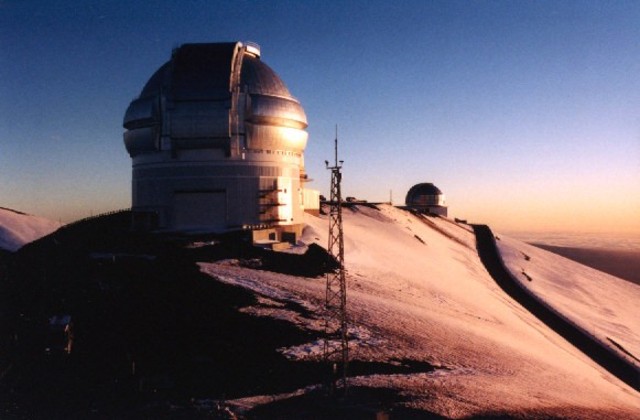
The 8.1 m Gemini North Telescope and UKIRT,
4,200 meters altitude, Mauna Kea, Hawaii
Photo (2002): Ovidiu Vaduvescu
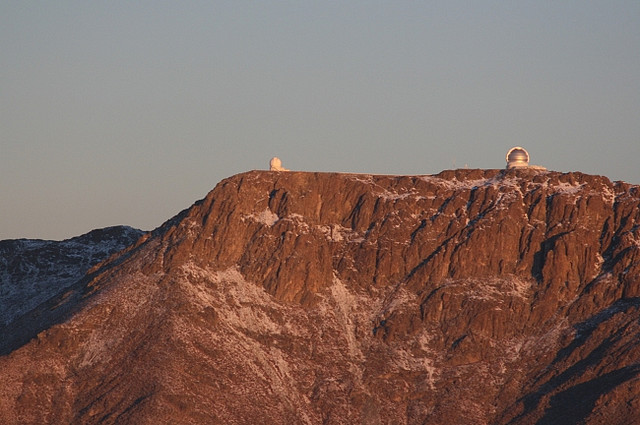
SOAR and the 8.1 m Gemini South Telescope,
2,700 meters altitude, Cerro Pachon, Chilean Andes
Photo (2008): Alex Tudorica
1
What is a telescope?
Simply, an instrument that
brings the Universe closer.
Mainly for science,
sometimes for curiosity or pleasure,
at other times for art.
And since astropoetry
(as a special form of art)
is dependent on astronomy…
2
A telescope is a technical work
that has a design.
So, it is also an artistic work.
3
A telescope is good
to collect more electromagnetic radiation,
would normally say a scientist.
A telescope is good
to collect more visible light,
would normally say an artist.
4
Since first the Universe
expresses itself through its image,
the first instrumental love of the sky lovers
is the optical telescope.
5
After I visited a few important observatories
and I read more astronomy books,
I tried to refresh and enrich my knowledge about telescopes
from Wikipedia.
Then I had an incredible succession of dreams,
in which I could travel in time and space
to see important moments
in the history of telescopes.
I began with the refracting telescope,
which uses lenses for creating the image.
Thus, in 1609, I asked Galileo Galilei:
“How did you feel watching the sky
through your 1.5 cm perspicillum
with a concave lens?”
“I saw a new beginning
of the Universe”
was his answer.
In 1611, I asked Johannes Kepler:
“How did you feel watching the sky
through your telescope
with a convex lens?”
“I saw clearer the enouncement of
all the laws of planetary motion”
he said to me.
Then I spoke with Johannes Hevelius:
“You made a 12 cm telescope in 1645,
founded lunar topography,
discovered four comets,
and your descriptions of seven southern constellations
were recognized in astronomy.
Wasn’t it too much?”
“One more job is good in any era”
he smiled.
A similar conversation with Christian Huygens:
“You correctly explained the rings of Saturn
and discovered a moon of the same planet.
However, how did you feel watching the sky
through your 22 cm aerial telescope,
that you built in 1686?
(My God, what an idea,
to keep the eyepiece on the ground
and to connect it to the aerial objective
by a string!)”
“I felt like the owner of a new home
on Saturn’s satellite Titan”
he answered.
Afterwards another century,
other dialogues:
“Chester Moore Hall,
how did you feel in the 1730s,
when you made the first achromatic doublet?”
“Just like the father of two new brothers.”
“But you, Peter Dolond, in 1763
when you made the first apochromatic triplet?”
“Just like the father of three new brothers!”
And after the first quarter of the 19th century…
“Von Struve,
how did you feel at the 24 cm Dorpat-Tartu Telescope
in Estonia
by measuring the parallax of Vega
at the first modern, achromat, refracting telescope in the world?”
“Like I was inspired by a song from the Lyre”
said the famous astronomer.
Then I saw two extraordinary moments of public enthusiasm:
around the 102 cm Yerkes telescope
at the World’s Columbia Exhibition of 1893 in Chicago
(this telescope was installed in 1897 in Wisconsin,
remaining the largest refractor used in world astronomy till today)
and around the 125 cm Great Paris Exhibition Telescope
at the Paris Universal Exhibition of 1900
(this telescope was the largest achromat ever built,
but only for demonstrations at that event).
Finally, I meditated
at the 76 cm Pulkovo telescope in Russia
a few years before it was destroyed in World War II:
“During wars, astronomical observatories are silent…”
6
My next dream was dedicated to the reflecting telescope,
which uses mirrors to create the image.
Thus, at the end of the 17th century,
I asked Isaac Newton:
“In order to minimize chromatic aberration,
in 1668 you made the first reflecting telescope (3.3 cm).
In 1687 you published the law of universal gravity.
What is the connection between them?”
“I prefer to tell you the difference,”
answered Newton,
“with or without my telescope,
gravity always exists!”
I congratulated
Robert Hooke for his 18 cm reflector made in 1673
after James Gregory’s design,
John Hadley for his 15 cm parabolic Newtonian
made in 1721,
and even William Herschel for his 1.26 m metal mirror reflector
made in 1789.
Then I went to Castle Birr in Ireland
to speak with the creator of
the Leviathan of Parsonstown,
the world’s biggest telescope (1.83 m) between 1848 and 1917.
“If the Biblical Leviathan was a prince of Hell,
then my Leviathan is a prince of Heaven”
William Parsons said to me.
Afterwards I was dumbfounded when
in sunny California
I visited
the 2.54 m Hooker Telescope on Mount Wilson
(the world’s largest from 1917 until 1948)
and the 5.08 m Hale Telescope at Palomar
(the world’s largest from 1948 until 1976).
I also visited the 6 m BAT in the Caucasus
(the world’s largest in 1976-1993),
where I asked myself:
“How could the Soviet communist atheist regime
build such a telescope just in the same massif
with the Biblical Mount Ararat?”
I continued after 1997
feeling like a star ranger
at the 9.2 m Hobby-Eberly Telescope in Texas,
and after 2005
by visiting the 9.5 m Southern African Large Telescope -
where I regretted that the constellation Camelopardalis (the Giraffe)
is so northern,
but I was consoled
by many charming southern constellations -
and the 8.4 m x 2 Large Binocular Telescope
- with the largest effective aperture in the world: 11.4 m! -
in Arizona,
where I had a titanic feeling,
maybe just like an excerpt from Hyperion…
7
I also visited a few solar telescopes
(which observe the Sun by detecting light
with wavelengths in the visible spectrum),
especially the solar towers on Mount Wilson in California
(built a few years after 1900,
one 18-m high and one 46-m high!),
and the avant-garde Einsteinturn in Germany
(operational since 1924 and touched by Einstein’s genius)…
Just a moment please.
Did I say Mount Wilson again?
Yes indeed,
the first Mount Olympus of the telescopes…
8
I postponed a visit to the McMath-Pierce Solar Telescope in Arizona
(the world’s largest of this kind)
because I had to fly to a few solar space observatories,
and I stopped on the Earth-Sun L1 Lagrange Point
(1,500,000-km away from the Earth toward the Sun),
at the Solar and Heliospheric Observatory,
not for spoiling the kindergarten
of its new discovered comets,
but for being in a more familiar environment,
which helped me to compare
old solar beliefs
with real solar images
given by the telescopes of the SOHO satellite.
But at the Greek mythology chapter,
I heard a superior voice:
“Are you a successor of Phaeton and Icar?
Those cheeky fellows got too close to me
and I had to destroy them!”
“Certainly not, Your Majesty Helios!”
I answered, scared.
“However,
you watch too many details of my life,
so you are closer to me
than they were before.”
I didn’t expect his next reaction
and I immediately came back to our planet,
not to disturb
the Great Luminous Crowned.
9
Regarding the robotic telescopes,
I think that Karel Capec would be glad
to find that his term (“robot”)
has advanced so far in practice,
while Isaac Asimov would be glad
to find that his Three Laws of Robotics
have been so brightly applied!
And for me,
it was fine to find out about these amazing programs:
ATF, RoboNet, LINEAR, RAPTOR…
I visited NASA’s Robotic Lunar Telescope in Arizona
(which operated between 1995 and 2003)
and I shouted:
“What a technical poem
for the glory of Selene!”
And I fully enjoyed a visit to
the large 3.9-m automated Anglo-Australian Telescope
in the Australian mountains,
where I felt like a robotic kangaroo
jumping from one star to another.
10
But before telling my dreams
about other types of professional telescopes,
I have to take a break
to express my gratitude
to those who have made instruments for amateur astronomy:
binoculars, Newtonian telescopes, Dobsonian telescopes…
and of course catadioptric telescopes
(which combine refraction - with lenses -
and reflection - with curved mirrors),
such as Schmidt-Cassegrain and Maksutov-Cassegrain…
making the optical telescope become
the great positive character.
Instruments so small physically,
but so gigantic morally,
that have enriched
the lives of sky lovers
and have kept alive the ideals of astronomy
for the public at large.
I would say that they have expanded
the Prometheic flame
into the Galilean flame!
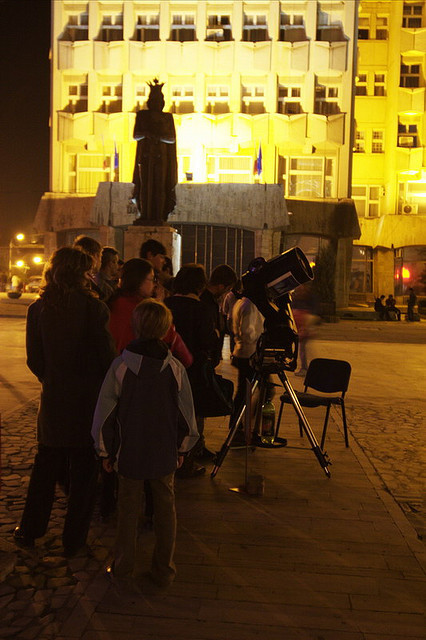
People around a telescope for amateurs
at SARM’s Targoviste festival of astronomy in October 2009,
(Winner of the Outstanding Galilean Nights Event Award,
a Cornerstone project of the International Year of Astronomy)
Photo: Valentin Grigore
11
In my most musical dream
I listened to a lot of astral symphonies
from radio telescopes.
Following the field open by
Karl Guthe Jansky,
builder of the first radio antenna for astronomy
in the 1930s
I began by visiting
the Effelsberg 100-m Radio Telescope
just to compare star music
with German classical music
by Bach, Beethoven, Schubert, Brahms, Wagner…
I continued with the (76-m high!) Lowell Telescope
at Jodrell Bank Observatory in England
just to compare star music
with British art rock bands,
and the Green Bank Telescope in West Virginia
(the world’s largest fully-steerable telescope)
just to compare star music
with the best American bands of blues, jazz and rock.
Then I dedicated my visits
to the incredible astronomical gardens
of the RATAN-600 radio telescope in Caucasus
(a 576 m diameter circle of rectangular radio reflectors!)
and of the Very Large Array in New Mexico
(27 independent antennas,
each of them with a dish diameter of 25 m!).
Obviously, I also visited
the fantastic Arecibo Radio Telescope in Puerto Rico,
with the main collecting dish of 305 m in diameter,
a giant saucer
filled with heavenly tunes!
But the most special moment was
when I felt like a penguin
mad from the celestial music
at the South Pole Telescope!
12
In another dream
I visited a few neutrino telescopes (detectors):
underseas
(NESTOR and ANTARES),
under a Japanese mountain
(Super-Kamiokande),
in a Canadian mine
(Sudbury),
and sunk in an Antarctic ice cap
beneath the South Pole Station
(AMANDA,
which in a way continues the exploring work of
Scott and Amudsen
not as a rivalry,
but as a unification).
What a formidable paradox,
to help the knowledge of the Universe
by detecting ghostly particles
from the underground!
13
Regarding my dream about flying (airborne) telescopes,
I began by going to a few balloons from 1950s and 1960s
and after that I jumped almost 50 years for a culminating visit to
NASA’s SOFIA
(Stratospheric Observatory for Infrared Astronomy),
carried by a performing Boeing.
Even the Wright brothers
would have been impressed!
14
When I visited some of the space telescopes
I had to be careful not to stumble
on so many artificial satellites
(it would have been risky,
even in a dream,
to fall to Earth from such a long distance).
And it was not easy to choose
from those telescopes,
mainly grouped by frequency:
gamma ray, x-ray, ultraviolet, visible,
infrared, microwave, radio…
But it was extraordinary for me
to visit ESA’s cornerstone missions
and NASA’s Series of Great Observatories Satellites:
The Hubble Space Telescope
(Oh Edwin Hubble,
this instrument with your name
gave us so many wonderful pictures,
auras for your demonstrations
that the Universe is expanding -
and as a consequence
the telescopic domain is expanding too!),
Compton Gamma-Ray Observatory,
Chandra X-ray Observatory…
while for the Spitzer Space Telescope
I even went to the solar orbit
(Oh Lyman Spitzer,
your Stellarator plasma device
makes me want to invent
an “Astropoetrator”!)!
I also travelled into the past to former space observatories
to commemorate:
the founder of heliocentric theory
at the Copernicus Observatory
and the founder of the theory of general relativity
at the Einstein Observatory;
I saluted the Hipparcos Catalogue of stars
at ESA’s mission with the same name,
and I relaxed with another round of star music
at the Japanese HALCA-VSOP space radio telescope…
Afterward I could not miss:
ESA’s INTEGRAL
(the most sensitive gamma-ray observatory ever launched),
NASA’s Kepler Mission
(on the Earth-trailing heliocentric orbit
your name Kepler
is connected now to the discovery
of Earth-like planets orbiting other stars!),
PAMELA
(Payload for Antimatter Matter Exploration and Light-nuclei Astrophysics),
and especially the Herschel Space Observatory
on the Sun-Earth L2 Lagrange Point -
the largest space telescope ever launched,
with a mirror of 3.5 m in diameter…
(Oh Herschel,
your name appears again,
this time because you discovered
infrared radiation
as an astronomical reality,
not as a fairy tale;
however, I’m sure that
the queen and the king of fairies,
Titania and Oberon
- today two moons also discovered by yourself
around the planet Uranus -,
are happy for you!).
Finally, I wanted to travel into the future
to visit 2018, the announced LISA
(Laser Interferometer Space Antenna,
able to detect and measure gravitational waves!)
by NASA and ESA,
but my dream stopped…
Never mind,
I’ll be patient till then…
15
My last telescopic dreams
carried me back on Earth,
to my favorite destinations:
the large international concentrations of telescopes.
But I began with the world’s largest national concentration of telescopes,
the Kitt Peak National Observatory in Arizona
(2100 meters in altitude),
which is part of the National Optical Astronomy Observatory in the USA
and hosts the largest and most diverse collection of astronomical instruments
on our planet,
the most impressive of them being
the McMath-Pierce Solar Telescope
(launched in 1962 as the world’s largest for solar research),
the 4-m Mayall Telescope and the 3.5-m WIYN Telescope;
I would say that for me
all was over here, in the Sonora Desert,
a bouquet of giant astronomical flowers
from the fascinating local “saguaro” cactus!
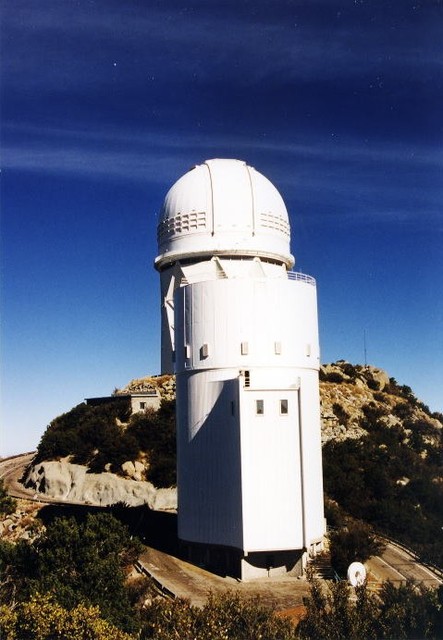
Sequence from the Kitt Peak National Observatory
Photo (2002): Yasuhiro Tonomura (Japan)
16
I continued with the highest (and the largest) international concentration
of huge telescopes:
Mauna Kea Observatories in Hawaii
(4,200 meters in altitude).
It was an exceptional cultural experience
to visit the Keck Observatory
(from 1993 until 2009, the world’s largest optical telescope;
a 10 m two-telescope observatory that can form
a single astronomical interferometer),
the prestigious 3.58 m Canada-France-Hawaii Telescope,
the United Kingdom Infrared Telescope
(the world’s largest dedicated infrared telescope),
and the James Clerk Maxwell Telescope
(another infrared, the world’s largest designed
to work in submiliteter regime…
…Oh Maxwell,
you made the first real color photography in 1861
and soon after that
you formulated the classical electromagnetism theory.
Certainly, in your work you needed
a little diversity!)…
And I was enthusiastic to watch
the Twin Brothers constellation
through the 8.1 m Gemini North Telescope
(that has a twin brother in the Chilean Andes)
and the M45 cluster of stars
through the 8.2 m Japanese telescope
named Subaru,
which means stars “gathered together” -
the Pleiades…
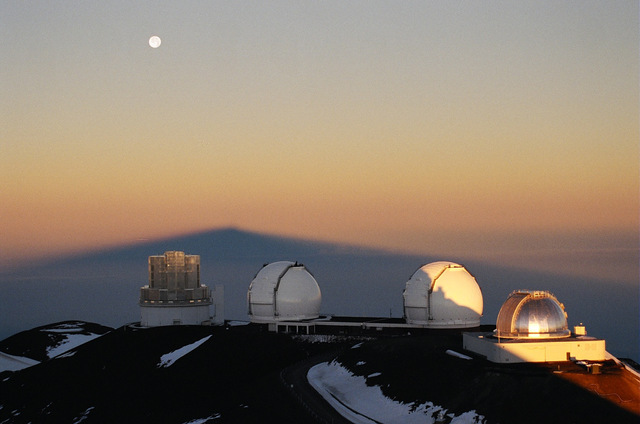
Sunrise over Mauna Kea Observatories
(Subaru, Keck Domes, and IRTF)
Photo (2004): Ovidiu Vaduvescu
17
Then I went south,
to a few places in Chilean Andes,
together giving
the world’s largest telescopic concentration.
First I visited La Silla Observatory
(2,400 meters in altitude),
a creation of the Southern European Observatory.
Dominated by the ESO 3.6 m Telescope,
a veritable general among other telescopes,
that place seemed to be an army
of cosmic conquerors…
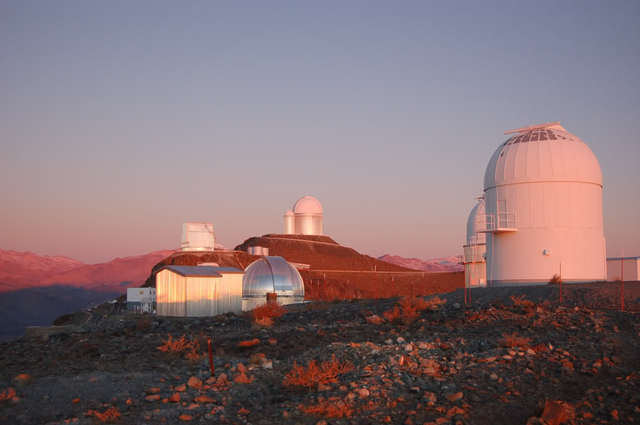
Sequence from La Silla Observatory
Photo (2007): Ovidiu Vaduvescu
18
I visited the Cerro Tololo Inter-American Observatory
(2,200 meters in altitude),
dominated by the 4 m Victor Blanco Telescope,
that seemed to be the active statue
of a wise giant…
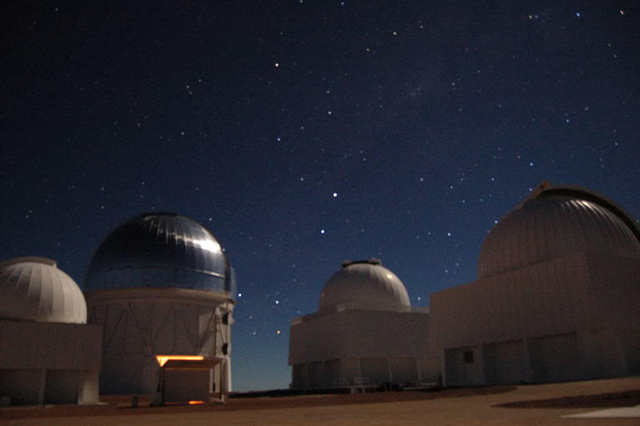
Nocturnal sequence from the CTIO
Photo (2008): Ovidiu Vaduvescu
19
I visited ESO’s Paranal Observatory
(over 2,600 meters in altitude)
with its Very Large Telescope,
composed of 4 (x 8.2 m) separate optical telescopes,
and my mind wasn’t even able to imagine
the 42 m European Extremely Large Telescope
(slated for 2018).
It was too much for me!
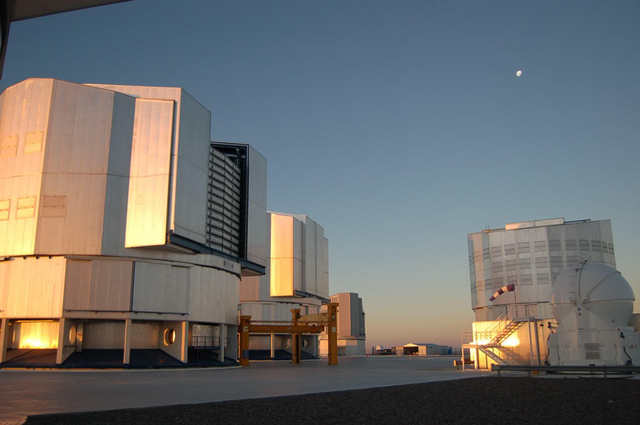
The Moon over ESO’s VLT, Paranal Observatory
Photo (2008): Ovidiu Vaduvescu
20
And I finished my Chilean adventure
by visiting Las Campanas Observatory
(2,400 meters in altitude)
with its 6.5 m Magellan Telescopes
(other famous twins of astronomy),
the prelude to the 24.5 m Great Magellan Telescope -
also planned for 2018!
(I was so glad to find
the name of Ferdinand Magellan over there!
In fact,
as the leader of the first circumnavigation of the Earth,
he made “one giant leap”
toward the knowledge of the Cosmos!)
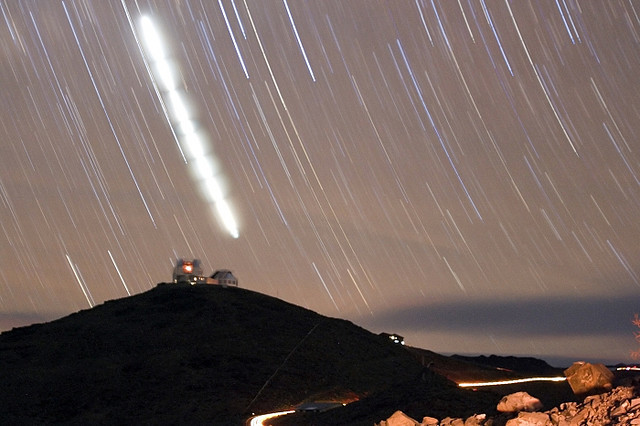
Star Trails and Jupiter over Magellan Telescopes, Las Campanas Observatory
Photo (2008): Alex Tudorica
21
My last dream was dedicated to
a visit to La Palma,
the most astronomical island on Earth,
host to the Observatorio del Roque de los Muchachos
(the largest international concentration of telescopes
in the northern hemisphere)
and the world’s largest optical telescope
(the 10.4 m Canaries Great Telescope,
launched in June 2009
in honor of the International Year of Astronomy).
And suddenly I woke up in October 2010
right in the middle of a real SARM expedition
on the same island,
the same observatory
and the same telescope…
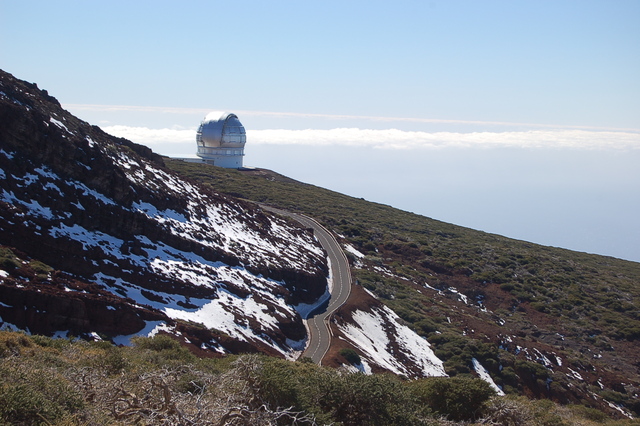
Gran Telescopio Canarias in La Palma
Photo: Ovidiu Vaduvescu
*
HOME NEXT